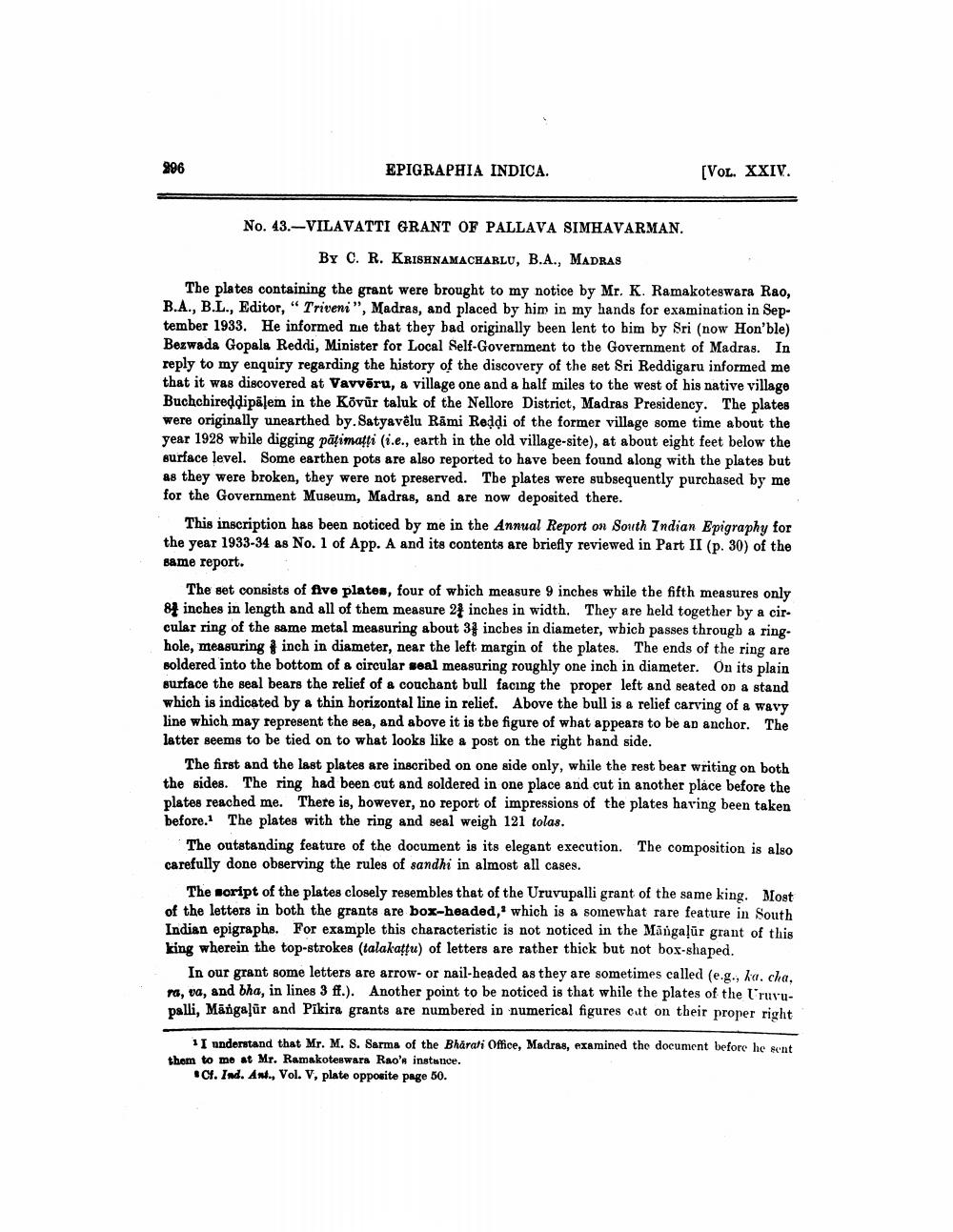________________
996
EPIGRAPHIA INDICA.
(VOL. XXIV.
No. 43.-VILAVATTI GRANT OF PALLAVA SIMHAVARMAN.
BY C. R. KRISHNAMACHARLU, B.A., MADRAS
The plates containing the grant were brought to my notice by Mr. K. Ramakoteswara Rao, B.A., B.L., Editor, " Triveni", Madras, and placed by him in my hands for examination in September 1933. He informed nie that they had originally been lent to him by Sri (now Hon'ble) Bezwada Gopala Reddi, Minister for Local Self-Government to tbe Government of Madras. In reply to my enquiry regarding the history of the discovery of the set Sri Reddigaru informed me that it was discovered at Vavvõru, a village one and a half miles to the west of his native village Buchchireddipalem in the Kövür taluk of the Nellore District, Madras Presidency. The plates were originally unearthed by Satyavēlu Rāmi Reddi of the former village some time about the year 1928 while digging pāțimatti (i.e., earth in the old village-site), at about eight feet below the surface level. Some earthen pots are also reported to have been found along with the plates but as they were broken, they were not preserved. The plates were subsequently purchased by me for the Government Museum, Madras, and are now deposited there.
This inscription has been noticed by me in the Annual Report on South Indian Epigraphy for the year 1933-34 as No. 1 of App. A and its contents are briefly reviewed in Part II (p. 30) of the same report.
The set consists of five plates, four of which measure 9 inches while the fifth measures only 84 inches in length and all of them measure 24 inches in width. They are held together by a cir. cular ring of the same metal measuring about 3 inches in diameter, which passes througb a ring. hole, measuring inch in diameter, near the left margin of the plates. The ends of the ring are soldered into the bottom of a circular seal measuring roughly one inch in diameter. On its plain surface the seal bears the relief of a couchant bull facing the proper left and seated on a stand which is indicated by a thin horizontal line in relief. Above the bull is a relief carving of a wavy line which may represent the sea, and above it is tbe figure of what appears to be an anchor. The latter seems to be tied on to what looks like a post on the right hand side.
The first and the last plates are inscribed on one side only, while the rest bear writing on both the sides. The ring had been cut and soldered in one place and cut in another place before the plates reached me. There is, however, no report of impressions of the plates having been taken before. The plates with the ring and seal weigh 121 tolas.
The outstanding feature of the document is its elegant execution. The composition is also carefully done observing the rules of sandhi in almost all cases.
The soript of the plates closely resembles that of the Uruvupalli grant of the same king. Most of the letters in both the grants are box-headed, which is a somewhat rare feature in South Indian epigraphs. For example this characteristic is not noticed in the Māngaļür grant of this king wherein the top-strokes (talakattu) of letters are rather thick but not box-shaped.
In our grant some letters are arrow-or nail-headed as they are sometimes called (e.g., ka, cha, ra, va, and bha, in lines 3 ff.). Another point to be noticed is that while the plates of the l'rurupalli, Mangaļūr and Pikira grants are numbered in numerical figures cut on their proper right
I understand that Mr. M. S. Sarma of the Bharali Office, Madras, examined the document before he sent thom to mo at Mr. Ramakoteswara Rao's instance.
Cf. Ind. Ant., Vol. V, plate opposite page 50.




